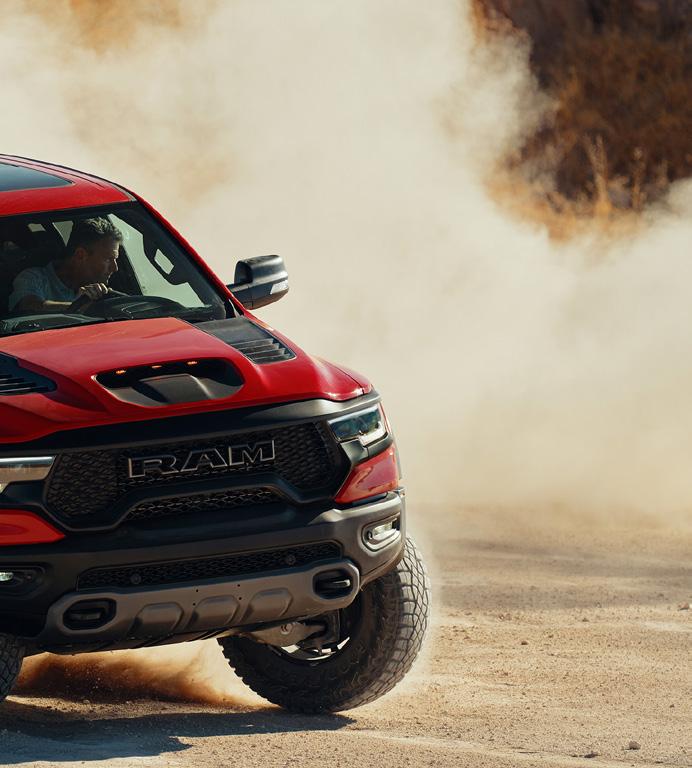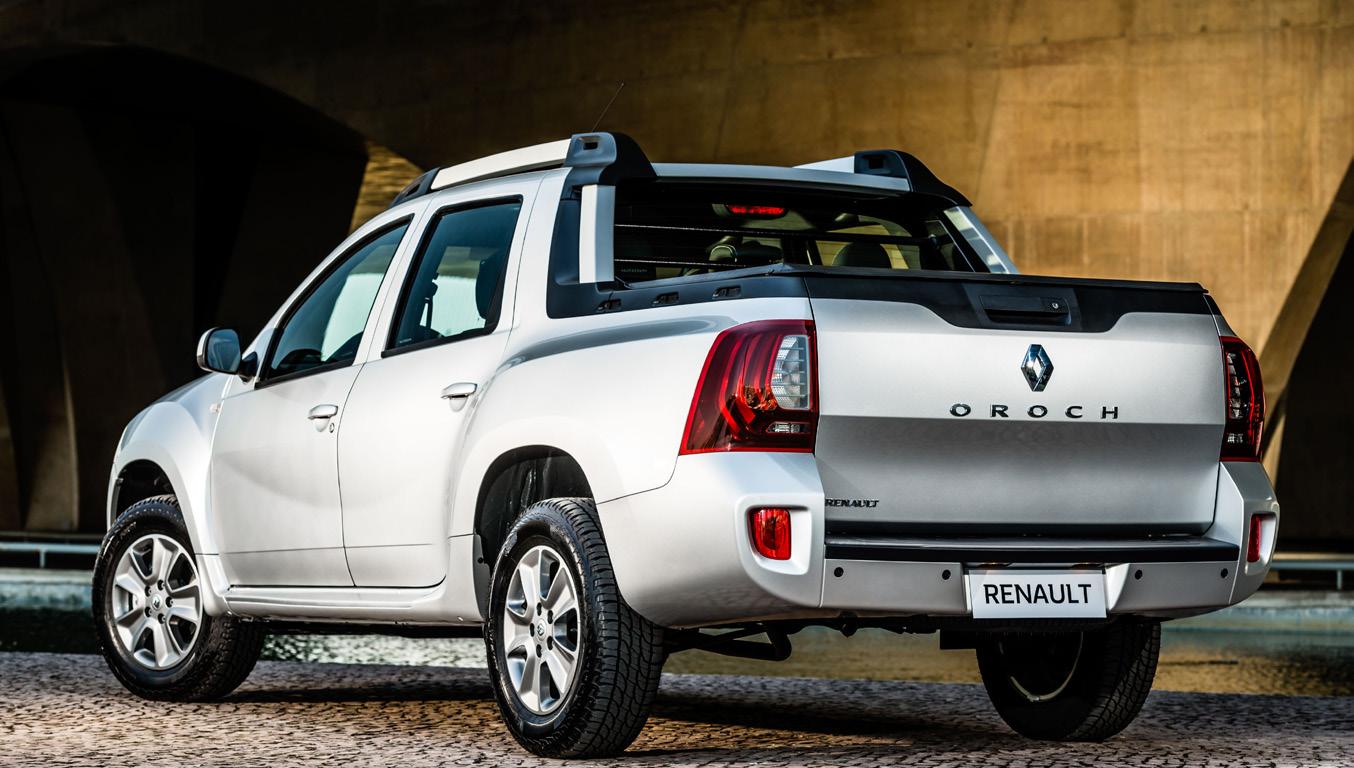
10 minute read
HOT OFF THE press
PRITESH RUTHUN
THERE’S no arguing that the X-Rider nameplate has fast established itself as a popular model within the Isuzu D-MAX line-up, initially only offered with the 2.5-litre high-output turbodiesel engine.
Advertisement
This year, though, Isuzu is taking things further with the introduction of a special edition D-MAX 3.0 TD Double Cab X-Rider Automatic model.

MAKINGS OF GREATNESS
“The X-Rider nameplate, which was first introduced in South Africa as a limited edition model in 2016, has been a great success for us. Until now we have only offered the X-Rider as a midrange vehicle available with the 100kW 2.5 litre engine,” says Dominic Rimmer, Executive, Technical Services at Isuzu Motors South Africa (IMSA).
“Based on the popularity of the X-Rider, we felt it would make sense to match this nameplate with our most powerful engine, while retaining the attributes which make the X-Rider so popular. The 3 litre X-Rider has an imposing presence on the road with a rugged and sporty look which sets it apart from regular D-MAX models.”
BUILT TO LAST
The 3.0 X-Rider Automatic is powered by the Japanese brand’s familiar four-cylinder 130kW turbo diesel engine from Isuzu. Matched with a six-speed automatic gearbox, maximum power output is reached at a low 3600rpm, with maximum torque of 380Nm achieved between 1800 and 2800rpm. According to official figures, it will sip 50ppm at a rate of 7.5l/100km in a combined cycle.
The X-Rider comes standard with black roof rails, black sports bar with Red X-Rider logo, black running boards, 20cm AX2 Radio with multifunction colour touch screen, black tailgate handle with rearview camera, and a 3.5 ton tow bar.
The bakkie’s seats are covered in black partial leather with red stitching and it is available in just three colours; Summit White, Switchblade Silver, Pull Me Over Red. Nice.
The vehicle rides on standard 18-inch diamond cut alloy wheels and all-terrain tyres. (Black alloy wheels are available as a no-cost option.)
PRICED TO SELL
The 3.0 TD Double Cab X-Rider Automatic slots in below the standard 3.0 Auto LX in the greater D-MAX line-up. This is great news for motorists who like the X-Rider look but want the benefit of the added pulling power of the more powerful four cylinder three litre engine.
Pricing for the special edition D-MAX 3.0 TD Double Cab X-Rider Auto starts at R551 100 and it comes with a five-year/120 000km warranty and a fiveyear/90 000km Service Plan as standard. ◆ For more information or to secure a test drive see www.isuzu.co.za.




Isuzu D-Max X-Rider

FORBIDDEN FRUIT
6 bakkies we want in SA
JASON WOOSEY
SOUTH AFRICA is bakkie country. We love them in all shapes and sizes because they’re always ready for whatever kind of work or play we throw at them.
Sadly, because we are one of the few countries that drive on the left, there are a lot of bakkies available abroad that simply can’t come to South Africa because they’re only built in left-hand drive.
Yes, folks there is a lot of loadlugging forbidden fruit out there, and these are our favourites.
Read and weep.
Gladiators are you ready?! While that somewhat cheesy chant is perhaps best left in the ‘90s, the word Gladiator took on a far cooler connotation when Jeep attached it to the back of its new double cab bakkie. The Gladiator is essentially a Jeep Wrangler with a load bin, and what’s not to like about that? It’s essentially a Swiss Army knife on wheels. Like its SUV cousin, the Gladiator can be “stripped” in numerous ways, with owners able to fold down the windscreen, remove the doors and lower the soft top for a truly open-air experience. Local buyers would love the brawny 3-litre turbo-diesel V6 engine option, which is good for 194kW and 600Nm.
The Gladiator also offers the very best 4x4 systems that Jeep has to offer, as well as Tru-Lock electrically operated front and rear axle lockers, a Trac-Lock limited slip differential and sway-bar disconnector.
Best of all, the workhorse aspect is not an afterthought in this vehicle, and it features an innovative “Trail Rail” cargo management system, as well as a bed lighting system and a 400W external power source for your tools.

1


3

4
THIS has been described as a bakkie for the Kardashians but wherever its appeal may lie, you have to agree that the GMC Sierra Denali is simply dripping bling. In fact there’s enough chrome on this thing to blind the sun.
GMC claims to have invented the premium pick-up segment almost 20 years ago, and the latest version continues its legacy of luxury, although it’s not without some innovative workhorse features. These include the MultiPro Tailgate, which is said to be the most innovative ever, with six unique functions and positions, offering enhanced second-tier loading. Buyers can also opt for a carbon fibre load bay, which is said to be the most durable in its segment. Kim and her pals don’t have to worry too much about towing either, thanks to the ProGrade Trailering System, with a Trailering App that removes much of the guesswork.
Cabin highlights include multi-colour head-up display, digital rear view mirror and open-pore wood trim. The adaptive suspension system is also quite unique in the bakkie world. The Denali is no slouch either, with buyers getting three options in the form of a 3-litre turbo-diesel, as well as 5.3-litre and 6.2-litre V8 petrols.
FORD F-150
THERE might not be a Raptor version as yet, but the new-generation Ford F-150 is still one of the tastiest pieces of forbidden fruit for South African bakkie buyers.
This is what the Ranger wants to be when it grows up.
There are plenty of different models and options to choose from, but what we really love about the F-150 is its wide array of innovative options aimed at making your work day easier. These include onboard generators that can be used to power tools at remote work sites and the Tailgate Work Surface that includes integrated rulers and clamps for cutting wood, and spaces to stash your phone, tablets and even your coffee cup. You can pretty much turn the cabin into an office with the Work Surface option, which has surfaces designed for laptop use and document signing, while the Max Recline front seats can fold to almost 180º to allow customers to camp in the cabin. The cockpit is cutting-edge too, thanks to Ford’s new Sync4 infotainment system, which allows for over-the-air system updates for downloading new tech features as they become available.
On the powertrain front, buyers can choose from a range of V6 and V8 petrol engine options, enabling towing capacities of up to 5 400kg. DESCRIBED as “the apex predator of the truck world”, the Ram 1500 TRX is ready to go Raptor hunting, and to give it an edge over its F-150 badged foe, it has borrowed a 6.2-litre heart from its Dodge Challenger Hellcat cousin.
The TRX’s 6.2-litre supercharged Hemi V8 is rated at 523kW and 881Nm, which Ram says is sufficient to launch it from 0-96km/h in 4.5 seconds, and on to 160km/h in 10.5s, making it the world’s fastest series-production pick-up truck. Even the quarter-mile time is astounding (for something that’s not a ridiculously overmodified VW Caddy) at 12.9 seconds.
The chassis, of course, was also purpose designed for bundu bashing in a hurry, and as a result it has 40% more wheel travel than the regular Ram 1500 that it’s based on. Other highlights include Bilstein Black Hawk e2 adaptive performance shocks, five-link coil rear suspension, a Dana 60 solid rear axle and an electronic locking differential.


5 6

The TRX’s 6.2-litre supercharged Hemi V8 is rated at 523kW and 881Nm, which Ram says is sufficient to launch it from 0-96km/h in 4.5 seconds, and on to 160km/h in 10.5s, making it the world’s fastest series-production pick-up truck. Even the quarter-mile time is astounding (for something that’s not a ridiculously overmodified VW Caddy) at 12.9 seconds.
The chassis, of course, was also purpose designed for bundu bashing in a hurry, and as a result it has 40% more wheel travel than the regular Ram 1500 that it’s based on. Other highlights include Bilstein Black Hawk e2 adaptive performance shocks, five-link coil rear suspension, a Dana 60 solid rear axle and an
FIAT STRADA DOUBLE CAB
BRAZIL is one of the few countries that shares South Africa’s love affair with small half-ton bakkies, and the South American country has some contenders in that market that would almost certainly do well in South Africa. At first we were inclined to include the obvious choice, the VW’s Saveiro. Yes, it would sell in droves if it came here, but it is looking a little dated and set to be upstaged by the all-new Fiat Strada that was revealed earlier this year.
This Strada is a far cry from the one that was once assembled in Rosslyn and unlike its VW rival the Fiat is now available as a double cab, with a 650kg payload, while a 729kg single cab is also available for those with more demanding loads. The Strada is available in three specs, Endurance, Freedom and Volcano, and the cabin boasts modern touchscreen infotainment with a CarPlay and Android Auto connectivity. Although it is still a compact bakkie, it could use a bit more power, with the top option for now a normally aspirated 1.3 petrol that’s worth just 74kW.
Now imagine a Ram or Dodge version of this with FCA’s 1.4 turbopetrol? ANOTHER bakkie from Brazil that would probably do well in South Africa is the Renault Duster Oroch. Of course, Renault SA has already flirted with the idea of bringing this to South Africa, but that all hinges around right-hand drive variants becoming available, which hasn’t happened as yet.
While closely based on the previous-generation Renault Duster SUV that we’re all familiar with, the Oroch has been stretched to a length of 4.7 metres, so in size terms its slots between the traditional compact bakkies and the larger one-tonners.
It’s not-too-big, not-too-small footprint could make it very popular with local buyers on a budget, while its 680kg payload should meet most urban needs.
Renault also offers an innovative tailgate extension system that allows owners to haul longer loads.
Unfortunately Renault’s 1.5 dCi diesel is not offered as an option, but buyers can still opt for a 2-litre normally aspirated petrol motor with 110kW, which should get the job done quite easily given that this is not a huge or heavy bakkie.



